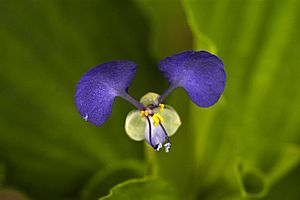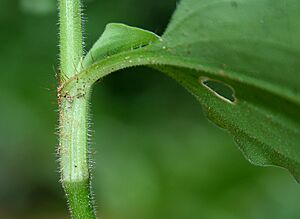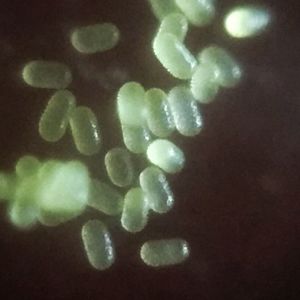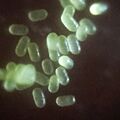Benghal dayflower facts for kids
Commelina benghalensis, also known as the Benghal dayflower, tropical spiderwort, or wandering Jew, is a plant that grows year after year. It is originally from tropical parts of Asia and Africa. This plant has spread widely to many other places around the world. These include the Americas, Hawaii, and the Caribbean islands. You can also find it on both coasts of North America.
This plant blooms for a long time. In warmer areas, it flowers from spring to fall. Closer to the equator, it can flower all year round. It often grows in places where the soil has been disturbed, like gardens or fields.
Quick facts for kids Benghal dayflower |
|
|---|---|
 |
|
| Scientific classification | |
| Genus: |
Commelina
|
| Species: |
benghalensis
|
| Synonyms | |
|
|
In both its home regions and new places, it is often seen as a weed. Sometimes it is a very serious weed. In the United States, it is on the Federal Noxious Weed List. This means it is considered a harmful plant that needs to be controlled. In Asia, it is a moderate weed in rice fields. In its native areas of Africa, India, and Southeast Asia, it causes big problems for many crops. These include tea, coffee, cassava, and peanuts. It can also harm crops by carrying tiny worms called nematodes and a plant virus called Groundnut rosette virus.
In China, people use this plant as a medicinal herb. They believe it helps with swelling, fevers, and inflammation. In Pakistan, it is used to treat skin swellings and as a laxative.
Contents
Where the Benghal Dayflower Grows

The Benghal dayflower grows in many places. It is native to tropical and subtropical Asia and Africa. In China, it likes wet areas. It can be found from sea level up to 2300 meters high. It grows in many Chinese provinces, from Hebei in the northeast to Hainan in the south. It is also found in Taiwan. In Japan, it grows in the southern parts of the country. Even though its roots can be eaten, this plant is not grown as a crop in Ethiopia. There, it just grows as a weed.
This plant has also spread far beyond its original home. It is now found in the southeastern United States, California, and Hawaii. It also grows in many Caribbean islands like Cuba, Jamaica, and Puerto Rico. In the southeastern U.S., it is found in Florida, Georgia, Louisiana, and North Carolina. It is still spreading. By 2003, it was a big problem for cotton crops in Georgia. This is because many common weed killers do not affect it much. It arrived in California in the 1980s. It often grows in disturbed areas like yards, lawns, and farms. It is especially common in cotton fields and orange groves.
How the Benghal Dayflower Looks
In some places, like Jammu, India, this plant grows for one year. It grows from May to December and flowers from June to October. In the Andaman and Nicobar Islands, which are closer to the equator, it grows year after year. There, it flowers all year long.
The Benghal dayflower has three kinds of branches. Some grow upwards into the air. Some grow sideways along the ground. Others grow underground. The underground branches do not have leaves.
How the Benghal Dayflower Reproduces
This plant has many ways to make new plants. It produces three types of flowers. Some are male, some have both male and female parts, and some are self-pollinating. All three types grow on the branches above ground. However, only flowers with both male and female parts grow on the sideways branches. Only self-pollinating flowers grow on the underground branches. Some plants may also have female flowers on their aerial branches. The developing flowers are covered in a sticky, leaf-like structure.
The flowers are not perfectly round; they are symmetrical in only one way. Their petals are blue. The male part of the flower has six stamens, but only three of them can produce pollen. One of these fertile stamens is longer and yellow. The other two are shorter and grey. The pollen grains are yellowish and shaped like capsules.
The female part of the flower has three connected sections. Flowers on the aerial and sideways branches have five tiny seeds inside each ovary. Flowers on the underground branches have three.
The seeds are oval-shaped. They are about 2 millimeters long and 1.5 millimeters wide. There are four types of seeds: large and small ones from above ground, and large and small ones from underground. Plants that grow from large underground seeds grow the fastest at first. This helps them compete better with other plants. All other types of seeds have a resting period. This helps them survive tough times, like droughts. It also helps them spread to new areas. Most seeds (75-77%) are the small aerial type. Only a small number (2-4%) are underground seeds.
What the Benghal Dayflower is Used For
In China, this plant is used as a medicine. People believe it helps with swelling, fevers, and inflammation. In Pakistan, it is used to feed animals. People also eat it as a vegetable. It is also used there as a medicine. People believe it can help with skin inflammation and act as a laxative. The people of Nepal eat the young leaves as a vegetable. They also use a paste from the plant to treat burns. A juice made from the roots is used to help with indigestion. In India, it has been used as a famine food when other foods are scarce. In Southeast Asia and Africa, it is used as animal food and as a poultice for medicinal purposes.
Images for kids



